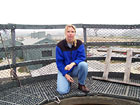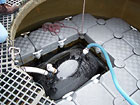

 | |||||||
|
|
Journals 2004/2005Barbara Simon-Waters
July 14, 2004 Today I arrived at the lab at 8am and Laura and I started preparing for her energetics experiment with Morgan, the vocal sea otter. She had the computer all set up to record the data. However, Brett, one of the trainers here, could not get Morgan to enter the kennel and therefore the experiment had to be nixed. One criterion here is that there should be no undue stress to the animal. It would not have worked to force Morgan into the kennel because then he would always associate it with something bad. Instead, they want him to "volunteer" to go into the kennel and be rewarded with lots of fish. The reasoning behind this is that if they ever need him to get into the kennel for safety reasons, he would readily do so. So we switched to Plan B and monitored the percent of oxygen in the tank. First, we had to bring a big tank of nitrogen over to the set-up and connect it to the computer. It is a system of checks and balances for accurately recording the percent of oxygen in the water entering the system in the tower. And now for the tower. I worried about that tower last night. Would I be able to climb up to the top? After all, it is about 350 feet high. It used to be part of the seawater system but is now used for Laura's experiments. If need be, they could switch it back to its original use. Laura went up ahead of me, scrambling like a cat to the top. I started out, my hands tightly gripping the bars as I made my way up. I went slowly and deliberately. About one-third of the way up is a platform where you transfer your feet from one ladder to another. I did so and then turned around to look. Kind of scary to look at the wonderful scenery when you are afraid of heights. But I was determined not to "wimp out." I continued up the second ladder and crawled in on my knees to the top. What a great view! I was really trying not to concentrate on the drop below. It certainly was a long way down and I did want to test gravity at this point! Once at the top, the experimental set-up includes a raft in the water with a dome to seal in the air with a standard amount of oxygen. A series of tubes are set up for monitoring. Crabs were placed in the water and of course settled at the bottom to hide in and among some concrete blocks to simulate the natural environment for the otter looking for food. I climbed down more quickly than I had climbed up, but still being just as cautious. We plan to do the experiment with Wick, the other sea otter tomorrow, and try again with Morgan on Friday. Laura had to leave to look over papers for her newly purchased house so I was left on my own. I went into the Costa lab and used the time to look up websites for my project. Carey eventually came back from taking Gitte to the San Francisco airport but was not feeling well. I sat in on her lecture on marine mammal diving physiology. I have to say that I am certainly learning a lot. The graphs have been great and I want to get copies of use in my class. These are graphs on some cool diving strategies. After the lecture, Carey and I went to check on LT and Forrest and to switch the pools again for LT and Forrest. Both animals cooperated beautifully. They are definitely intelligent animals. I forgot to mention that all the elephant seals have been named for characters in the Forrest Gump movie. There have already been a Jennie, Gump , and Bubba. Carey did not feel well so I weighed out the 4 kg of fish for Forrest, cut the slits in the fish, tested the pool temperature, and proceeded to warm the fish to the pool temperature. I then entered the pool area of Forrest by myself and fed Forrest. I timed the feeding and recorded it on Carey's data sheets. It was somewhat unnerving to be in the pool area with Forrest all by myself. He is a big animal with powerful jaws but I managed to get him into the pool and fed him without incident. This was certainly a day of firsts for me. My palms should not sweat so much climbing up tomorrow as they did today. Tomorrow should prove to be an interesting day. So much excitement! (Click on thumbnails below for full version pop-up) Return to Journals Index |
||||||





